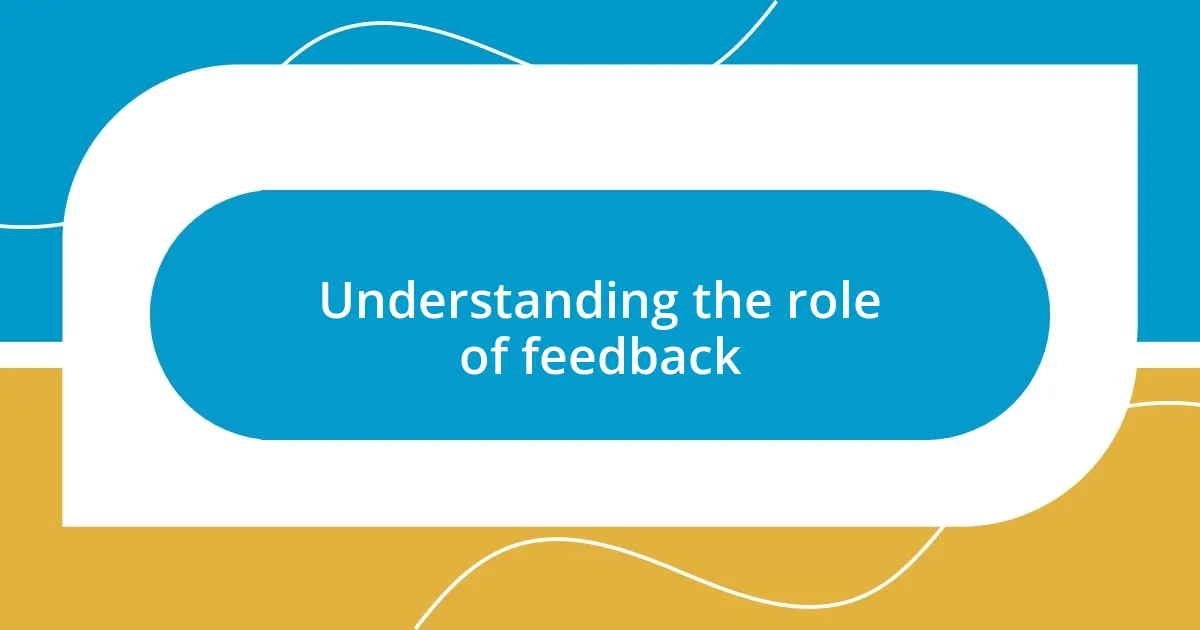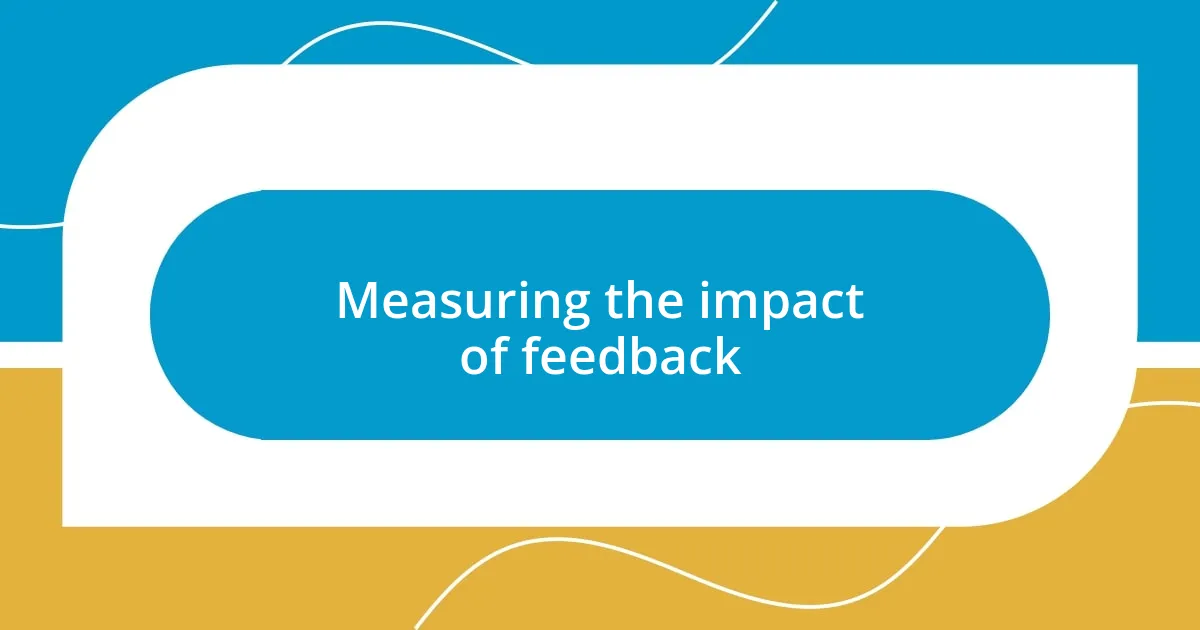Key takeaways:
- Feedback acts as a guiding tool in branding, helping to identify blind spots and align messaging with audience expectations.
- Both qualitative and quantitative feedback are essential; qualitative insights reveal emotional connections, while quantitative data tracks performance trends.
- Engaging directly with customers through conversations and structured feedback sessions fosters deeper understanding and innovative ideas.
- Implementing feedback loops promotes continuous improvement, enriching brand strategy and enhancing customer satisfaction over time.

Understanding the role of feedback
Feedback serves as a compass in the branding journey, guiding decisions with clarity. I remember a time when I was uncertain about a brand logo’s impact. Seeking thoughts from diverse audiences helped me see how others perceived it—a fresh perspective that reshaped my design approach was invaluable.
One of the most memorable moments for me was when I received constructive criticism about my brand messaging. Initially, I felt defensive, but when I took a step back, I realized this feedback highlighted a disconnect with my audience. How often do we miss key insights simply because we’re too attached to our own ideas?
The emotional rollercoaster of receiving feedback can be daunting, but it also brings growth. I’ve learned to embrace feedback—a vital step in refining my branding efforts. Isn’t it fascinating how others can illuminate blind spots we never knew existed? This exchange not only strengthens our brands but also deepens our understanding of our audience.

Types of feedback in branding
When it comes to feedback in branding, there are several types worth considering that can significantly influence our strategies. I’ve found that qualitative feedback often provides deeper insights into emotional responses. This type of feedback, gathered through open-ended surveys or interviews, helps uncover the underlying feelings and values that resonate with my audience. Just the other day, I spoke with a loyal customer who genuinely shared how our brand message made her feel empowered. Her words painted an emotional picture that quantitative data simply couldn’t capture. It reminded me how powerful personal stories can be in shaping a brand’s identity.
On the flip side, quantitative feedback offers a more structured approach, allowing me to analyze trends and measure impact. This can be particularly useful for evaluating brand awareness or customer satisfaction. Here’s a quick breakdown of the types of feedback in branding:
- Qualitative Feedback: Personal insights from customers that reveal emotional connections to the brand.
- Quantitative Feedback: Data-driven insights, such as surveys and performance metrics to track satisfaction levels.
- Direct Feedback: Immediate reactions from customers during or after interactions with the brand.
- Peer Feedback: Input from other professionals within your industry that provides an external perspective on your branding efforts.
- Social Media Feedback: Comments, shares, and likes that offer insights into public perception and engagement levels.
These varied feedback types have the potential to transform my branding journey, allowing room for growth and alignment with audience expectations.

Collecting valuable customer feedback
Collecting valuable customer feedback is crucial for understanding how my brand resonates with its audience. One time, I set up a simple online survey after a product launch to gauge reactions. The insights I gleaned were astounding; customers not only provided ratings but shared stories about their experiences. I felt a wave of connection wash over me as I read through their words—feedback that was both validating and eye-opening.
Engaging customers directly can also lead to meaningful conversations. I vividly recall a phone call with a long-time supporter who took the time to express how my brand had been a part of her family traditions. Her emotional investment struck a chord with me, prompting adjustments to our marketing materials to reflect that warmth and connection. This personal touch in gathering feedback reminds me that customers aren’t just numbers—they are individuals with stories that can deeply influence brand direction.
Lastly, while informal channels like social media can quickly provide reactions, I’ve found that structured feedback often yields the richest insights. I once moderated a focus group, and the energy in the room was palpable. The participants not only critiqued our latest campaign, but also engaged with each other, sparking ideas I hadn’t considered. This experience reinforced the value of creating spaces where customers feel comfortable sharing their thoughts, leading to a collaborative dialogue that can truly elevate branding efforts.
| Method | Insights Gained |
|---|---|
| Online Surveys | Rating scales reveal trends, while open-ended questions capture emotional stories. |
| Direct Conversations | Personal stories highlight real-world applications and create emotional connections. |
| Focus Groups | Dynamic discussions generate collaborative feedback and spontaneous ideas from participants. |

Analyzing feedback for branding insights
Analyzing feedback for branding insights involves diving deep into what customers are truly saying about my brand. I distinctly remember reviewing the comments from a recent social media campaign; while metrics showed an uptick in likes, it was the detailed feedback that caught my attention. One user shared how our brand’s commitment to sustainability inspired them to make changes in their own lifestyle. It made me realize the profound impact our messaging can have, beyond just sales.
When I analyze feedback, I often find surprising revelations hidden within the details. For instance, I once collated responses from focus group discussions, where a participant pointed out that our brand colors reminded her of her grandmother’s garden. This personal connection tugged at my heartstrings! Those colors weren’t just visual elements; they stirred nostalgia and warmth, prompting a redesign that included that emotional richness. Isn’t it incredible how something as simple as a color can evoke such strong feelings?
I also try to remain open-minded when it comes to constructive criticism. During a branding workshop, a fellow entrepreneur highlighted that our messaging could be clearer. At first, I felt a twinge of defensiveness—who enjoys hearing negative feedback? But upon reflection, I understood how crucial clarity is in creating an authentic connection with our audience. This insight helped refine my approach and brought me closer to my goal of fostering genuine relationships through branding. How has feedback reshaped your perceptions of your brand?

Implementing feedback into brand strategy
Implementing feedback into brand strategy can be transformative. I once had to pivot a campaign after receiving insightful comments on our messaging. It hit me that what I thought was clear was actually muddled for many customers. By integrating their feedback, I refined our messaging to be more straightforward and relatable, which significantly boosted engagement.
I remember a time when I hosted a brainstorming session with our team, presenting feedback from our audience. Among the critiques, one individual’s suggestion stood out: introducing a behind-the-scenes look at our production process. It resonated with me because transparency builds trust, and implementing this idea not only enhanced our authenticity but also created an emotional connection with our audience. How often do we overlook the simple suggestions that could strengthen our brand’s bond with its customers?
Experimenting with feedback is a crucial step in refining my brand strategy. After launching a new product that received mixed reviews, I decided to take action. I organized a small event where customers could interact with the product directly and share their thoughts in real-time. Their candid reactions not only provided immediate insight but also sparked fresh ideas for future iterations. This hands-on approach reminded me that feedback isn’t just a tool; it’s a stepping stone to fostering innovation and creativity within my brand. What unexpected opportunities have you discovered through customer interactions?

Measuring the impact of feedback
Measuring the impact of feedback can often feel like deciphering a rich tapestry of emotions and sentiments. I vividly recall the day I sifted through a mountain of responses after launching a new logo. One comment, in particular, stood out—a customer expressed how the design made them feel seen and represented. That moment was powerful; it showcased just how deep feedback could dive into the emotional landscape of branding. It begs the question: How often do we consider the feelings our brand evokes in others?
Quantifying feedback requires more than just numbers; it demands interpretation. One time, I tracked a surge in website visits after a campaign rebrand, yet the engagement statistics didn’t quite align with the excitement I had anticipated. Upon deeper investigation into comments, I noticed recurring themes regarding confusion in our message. This taught me that while metrics are helpful, the story behind them is what truly reveals the impact of our efforts. Have you ever faced discrepancies between data and personal stories?
I also learned to prioritize feedback sources based on their relevance. During a quarterly review, I came across feedback from a vocal customer advocate who passionately defended our brand online. Their insights were not only constructive, but they also resonated with our core values. Engaging with them led to a deeper understanding of loyalty and connection, highlighting how one strong voice can guide broader brand strategy. Isn’t it fascinating how individual experiences can shape the overall narrative of a brand?

Continuous improvement through feedback loops
Feedback loops create a dynamic environment for continuous improvement, and I’ve seen this firsthand in my experience. After noticing a dip in customer satisfaction, I initiated a simple yet effective weekly check-in with our audience. By asking specific questions about their experiences, I was amazed by the wealth of suggestions that flowed in. This consistent engagement not only clarified their expectations but also turned proactive feedback into actionable insights, reinforcing the importance of staying connected.
One memorable instance was when I received feedback about our user interface. Initially resistant to change, I decided to put aside my ego and explore the suggested adjustments. Upon implementing these changes, not only did we see a spike in usability ratings, but the excitement expressed by our users felt electrifying. It’s a reminder that embracing feedback can sometimes lead to epiphanies we might not have considered. How can we champion the voices of our customers to foster a culture of continuous improvement?
The integration of feedback loops didn’t just enhance our products; it transformed our brand’s narrative. I organized quarterly feedback workshops where we celebrated both progress and obstacles. One session prompted a deep discussion about inclusivity, leading to a campaign adjustment that resonated brilliantly with a wider audience. Listening to my customers’ stories catalyzed an evolution in our branding that I hadn’t anticipated. Isn’t it incredible how a simple conversation can pivot our understanding and direction?













